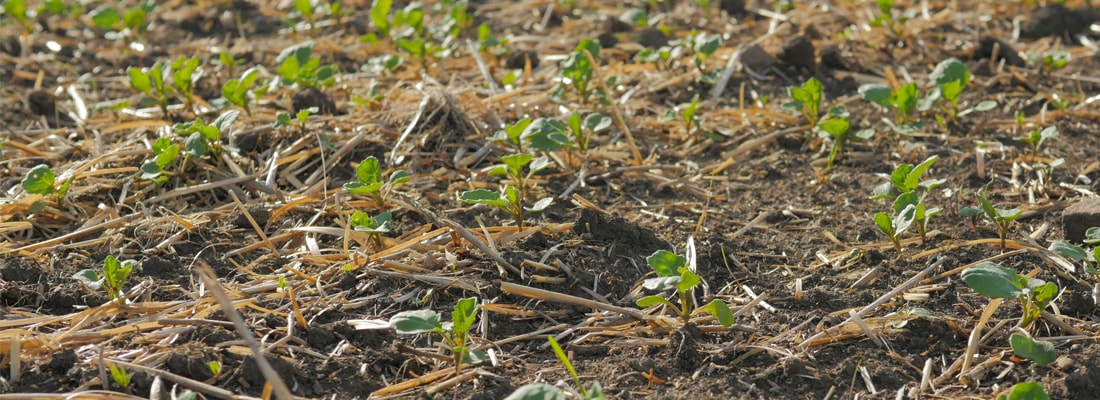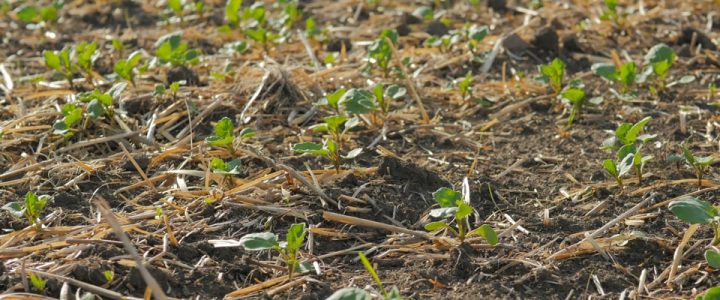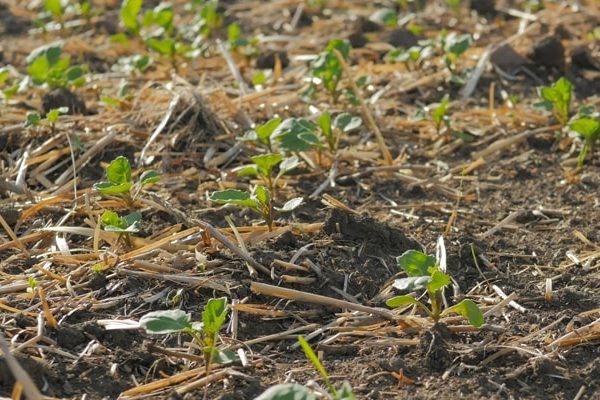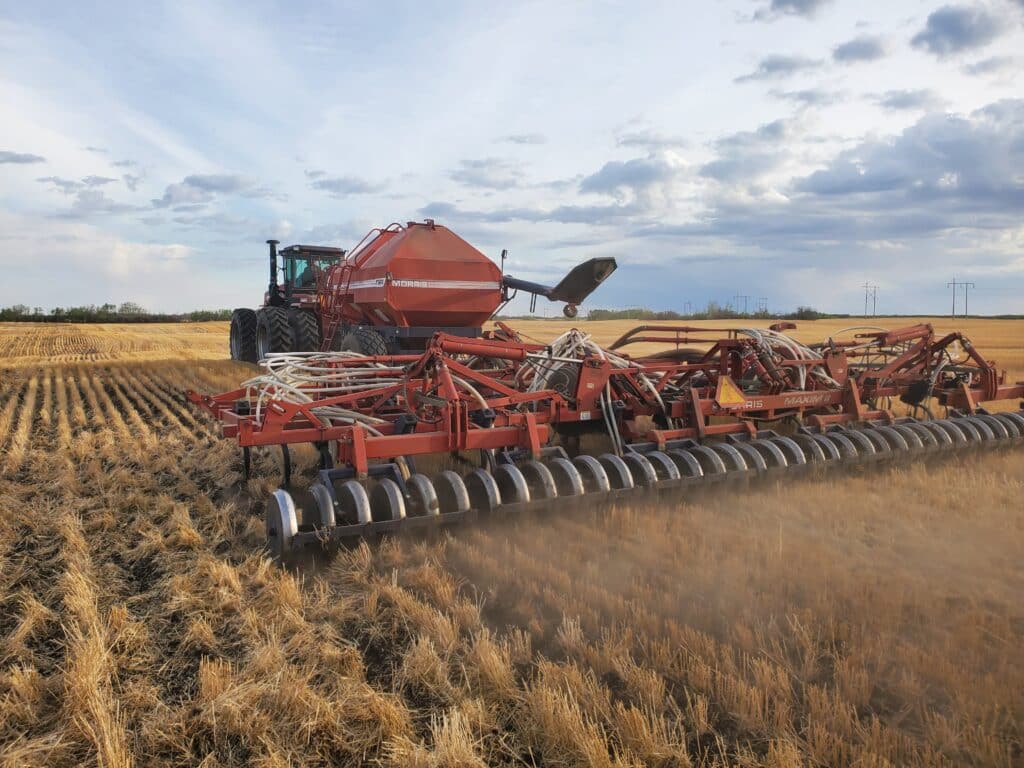A favourable seedbed is important for good stand establishment, especially since canola seeds are relatively small compared to other commodities, and canola emergence rates remain a major challenge.
For optimal canola seedbeds, it is important to note:
- Residue from the previous crop must be spread evenly, especially in no-tillA type of tillage management technique where soil is undisturbed from harvest through planting, seeding with narrow knives/hoes or discs. More fields, so seeding implements (equipment) can accurately place all seed into the top 1-2.5 centimetres (~0.5-1 inches) of soil and so seedlings have a relatively even layer to grow through.
- Canola seeded into standing stubble tends to have higher yield potential than canola seeded into cultivated stubble.
- Some on-row packing is necessary to improve seed-to-soil contact and seal the soil to limit moisture loss. Packing pressure will vary with soil conditions, but generally very little packing pressure is required.
Residue management
Uneven residue on the soil surface can prevent drill openers from penetrating residue to place seed into soil. Residue can also fall into the seed row, preventing furrow closure and good seed-to-soil contact. Therefore, residue management is a crucial aspect for successful conservation tillage seeding.
Successful residue management needs to consider various factors, including:
- crop residue amounts and condition, particularly green, lodged or damp straw
- capability of the seeding equipment and other implements to clear through the crop residue without plugging or “hairpinning” (when straw is forced down by an opener instead of being cut, so the seed lands on top of the straw and either the seed doesn’t get any contact with the soil, or it gets pushed out when the straw bounces back after the opener passes)
- combine intake or swather cut width compared to the width of straw and chaff exiting out behind the combine
- alternative uses for straw when residue is excessive (ex. baling)
- weed control methods
Residue management starts with the combine, may include harrowing or tillage, and ends with seeding equipment.
The combine must be able to spread residue the full width of cut for the swather or straight cut header, creating a relatively even matt over the whole soil surface. Most new combines are equipped with good straw choppers and chaff spreaders or are easily adapted with after-market units, but these must be maintained in good condition to break up straw and chaff and distribute it properly. If distribution behind the combine is not adequate, tillage or harrowing may be able to fix the problem — at risk of losing some snow catching stubble and at greater cost of fuel, labour and machinery. With residue spread evenly, the seeding equipment still has to allow crop residue to pass through without bunching, and the opener must prevent chaff residue from falling into the seed furrow and causing poor seed cover and poor furrow closing.
The most common locations for plugging in the seeder are:
- between the underside of the shank (may be the spring trip supporting mechanism) and the soil surface
- between one ground opener and the next
- between a ground opener and a wheel or some other adjacent structural member
The critical dimension may vary with the amount of crop residue on the surface, the moisture content of the residue or even the air humidity. Damp straw plugs the seeder quite easily. Fluffy straw plugs more easily than straw lying on the soil surface. Dry straw on a warm, breezy day will pass through a seeder while damp straw may not. Changing speed and direction of travel may help a seeder to clear crop residue.
The straw handling performance of many seeders may be improved by modifying the location where plugging most often occurs. The space between the opener and “plug point” may need to be increased, sometimes greatly, to prevent plugging. Four-rank cultivator units on air drills will plug less than three-rank units.
Residue managers are spike wheels attached to the front side of each drill opener shank. The spike wheels clear away residue or hold residue in place temporarily, leaving a narrow strip of bare soil for the opener. The Farm Stewardship Centre (formerly the AgTech Centre) in Lethbridge investigated the effectiveness of residue managers in 2007 and found that some were able to facilitate seeding without plugging, although differences in crop emergence and final yield turned out to be infrequent 1.
Research from the Peace River region found that a narrow strip of bare soil over the seedbed could help canola overcome most of the cold temperature and excessive moisture disadvantage of direct seedingA seeding method where the crop is sown into the field without any previous spring tillage operations. More in unfavourable situations. The research in silt loam and sandy loam soils in 1992 and 1993 compared canola and barley production in no-tillage (NT), modified no-tillage where surface residue was pushed aside from a 7.5 centimetre zone above the planting rows (MNT) and conventional tillage (CT). Seed zone temperatures were higher in MNT and CT than in NT. The MNT was more beneficial for crop establishment during prolonged dry periods than CT, and for emergence and growth compared with NT under extremely wet soil conditions 2, 3, 4.
Agriculture and Agri-Food CanadaAgriculture and Agri-Food Canada is a department of the Government of Canada. More research in Swift Current, Saskatchewan, a semi-arid part of the Canadian Prairie, assessed the effect of stubble management on the microclimate, water use and seed yield of canola. Tall (30 cm), short (15 cm) and cultivated stubble treatments were deployed in fall and in spring. Tall stubble increased seed yield of canola by about 24% and water use efficiency (WUE) by about 19% compared with stubble cultivated in the fall. In fields that overwintered as tall stubble and then were cultivated or trimmed in the spring, tall stubble increased canola yield by about 16% and WUE by about 11% compared with cultivated stubble. The differences in wind velocity, soil temperature and solar radiation reaching the soil surface indicated significant modification of the microclimate by tall compared with cultivated stubble 5.
A subsequent AAFCAgriculture and Agri-Food Canada is a department of the Government of Canada. More study found that crop yield and the overall average water use efficiency increased linearly as stubble height increased to 45 cm 6.
Learn how five wheat residue management strategies (two different combine choppers, a check with no further management, a heavy-harrowed treatment, and a tilled treatment) compared for canola emergence and yield in the Effect of cereal crop residue distribution on the following year’s canola emergence and yield study.
Packing soil
Soil must be repacked around and above the seed to prolong seed contact with moist soil. Packing reduces moisture loss from the seedbed by creating a denser soil layer at the surface with fewer large air spaces.
A fine balance often exists between packing enough to reduce moisture loss and packing too much, which in some soils may promote crusting that hinders seedling emergence. Adequate packing is achieved when all the soil lumps are crushed both around and above the seed.
In general, canola needs minimal packing for optimum crop establishment. Some packing will improve stand establishment under dry conditions, but over-packing can promote crusting, especially in high clay and other crust-prone soils, and reduce crop emergence in wet soil conditions 7.
Yield response to any type of packing pressure is limited, likely because canola can branch out and compensate for poor stand establishment. However, lighter soils more prone to moisture loss and less prone to over-packing and may benefit from heavier packing pressure 7.
Most ground openers require a packer to close and pack the soil in the furrow to create a good seedbed. The packer’s shape and width must conform to the furrow and the location of the seed underneath. A direct, minimum disturbance seeder requires an on-row packer. A wide sweep opener that cuts the full width of the seedbed requires a harrow, rod-weeder, packer or a combination of several systems to finish the seedbed.
There does not seem to be one best opener-packer combination for canola. An Agriculture and Agri-Food CanadaAgriculture and Agri-Food Canada is a department of the Government of Canada. More and PAMI study compared various opener and packer combinations and concluded that the advantages were minor and likely of little agronomic or economic significance to most farmers 7.
Footnotes
- Papworth, L., Metzger, B., Vanee, J. 2007. Investigation into use of residue managers during direct seedingA seeding method where the crop is sown into the field without any previous spring tillage operations. More with double shoot angle disk openers. AgTech Centre, Lethbridge, Alberta.
- Arshad, M. A. and Azooz, R. H. 2003. In-row residue management effects on seed-zone temperature, moisture and early growth of barley and canola in a cold semi-arid region in northwestern Canada. American Journal of Alternative Agriculture. 18 (03): 129-136.
- Azooz, R. H. and Arshad, M. A. 2001. Soil water drying and recharge rates as affected by tillage under continuous barley and barley-canola cropping systems in northwestern Canada. Can. J. Soil Sci. 81: 45–52.
- Bruce, S.E., Ryan, M.H., Kirkegaard, J.A. and Pratley, J. 2006. Improving the performance of canola in retained wheat stubble. Aust. J. Agr. Res. 57: 1203-1212.
- Cutforth, H.W., Angadi, S.V. and McConkey, B.G. 2006. Stubble management and microclimate, yield and water use efficiency of canola grown in the semiarid Canadian prairie. Can. J. Plant Sci. 86:99-107.
- Cutforth, H., McConkey, B., Angadi, S. and Judiesch, D. 2011. Extra-tall stubble can increase crop yield in the semiarid Canadian prairie. Can. J. Plant Sci. 91:783-785.
- Johnston, A.M., et al. 2003. Opener, packer wheel and packing force effects on crop emergence and yield of direct seeded wheat, canola and field peas. Can. J. Plant Sci. 83: 129–139.




